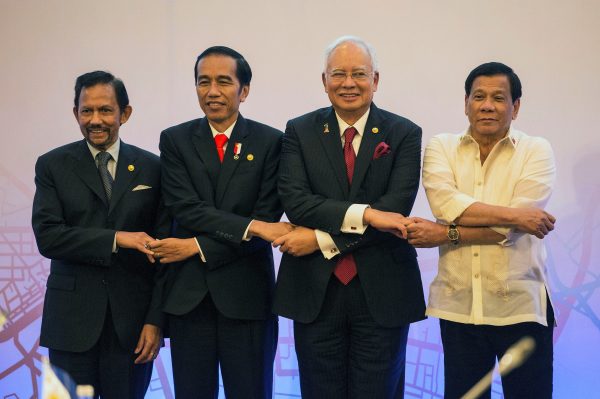The initiative was meant to address a lack of socio-economic development in these remote areas. Around the same time, other parallel subregional initiatives like the Indonesia-Malaysia-Thailand Growth Triangle, and region-wide integration initiatives such as the ASEAN Free Trade Area emerged. BIMP-EAGA was hence conceived during an era of hope for substantial socio-economic advancement through cooperation.
But the initiative slowed significantly in the wake of the 1997–1998 Asian Financial Crisis. An intergovernmental coordinating body, the Facilitation Center, was only established in 2003, almost a decade after the initiative was launched. It was also only in 2003 that the first BIMP-EAGA Leaders’ Summit was held, on the sidelines of an ASEAN summit.
Three important documents since then have guided the development of BIMP-EAGA: Roadmap to Development (2006-2010), Implementation Blueprint (2012-2016) and BIMP-EAGA Vision 2025 (2017-2025). These documents laid out the grouping’s ‘strategic pillars’, its major economic sectors and crucial projects that would help realise the BIMP-EAGA vision for a ‘resilient, inclusive, sustainable, and economically competitive subregion’.
China was one of the earliest non-ASEAN countries to engage with BIMP-EAGA. In 2009, China and BIMP-EAGA signed a Framework of Cooperation document, affirming the former’s role as a ‘strategic development partner’. Not much happened in the decade after.
China has stepped up in recent years, as it has aimed to cultivate more comprehensive and multi-layered ties with ASEAN. In November 2018, the first ministerial-level meeting between China and BIMP-EAGA was held, where it was agreed that cooperation between the two needed to be enhanced. The second ministerial-level meeting was held in November 2019, with the Plan of Action for BIMP-EAGA China Cooperation 2020–2025 adopted. In addition to priority areas identified in the 2009 Framework of Cooperation, new areas include the digital economy and poverty alleviation, while exploration of minerals and finance were dropped from the 2009 list.
China’s growing focus on BIMP-EAGA can be seen in its recent joint statements with Brunei and Malaysia, and in a Xi Jinping speech in late 2020, where it was identified as a key area of China–ASEAN cooperation. The ASEAN-China Joint Statement on Synergising the Master Plan on ASEAN Connectivity 2025 and the Belt and Road Initiative, adopted in Bangkok in 2019, also mentions BIMP-EAGA. On the ground, China has four consulate offices, making it — along with Australia and Japan — among the countries with the greatest consular presence in BIMP-EAGA.
COVID-19 and the challenges of post-pandemic economic recovery present opportunities for China to be a meaningful BIMP-EAGA partner. In many aspects, BIMP-EAGA remains comparatively backwards in terms of socio-economic development. With the exception of Brunei, the per capita GDP of other BIMP-EAGA economies ranks much lower than their national averages.
Whether in terms of infrastructure, the digital economy, agriculture, green technology, public health, tourism, industrial parks or human capacity building, China has the capacity and resources to support BIMP-EAGA. It also has the motivation to demonstrate its commitment to the provision of public goods in less-developed areas in the world, especially in the context of its tense relations with much of the developed world.
But China needs to be careful. There are ongoing territorial and maritime disputes among BIMP-EAGA countries, while piracy and terrorism remain active in certain areas. The ‘central–periphery’ dynamics in BIMP-EAGA are the most sensitive ones, with the national capitals extremely wary of local centrifugal forces or even outright secessionist movements in the subregion. China will have to walk a fine balance between engaging with local actors and central authorities.
Moreover, by virtue of its nine-dash line in the South China Sea, China has overlapping territorial or maritime disputes with all four BIMP-EAGA countries. While the South China Sea disputes do not necessarily prevent China–BIMP-EAGA cooperation, any intensification of the disputes will negatively impact the latter. But absent a functioning cooperative platform in the South China Sea, China–BIMP-EAGA cooperation may be a meaningful alternative for these countries.
Geopolitically, increased Chinese presence in BIMP-EAGA may also be alarming for the United States. At present, the United States has a minimal presence in BIMP-EAGA. But two US allies, Australia and Japan, maintain an active presence. BIMP-EAGA is geographically closest to Australia and covers important trade routes between Australia and other parts of the world, while Japan has traditionally been the main development partner of BIMP-EAGA.
China’s entrance into BIMP-EAGA could spur a competitive dynamic that prompts Australia and Japan to increase their investment and economic assistance to the subregion. But the competitive dynamic need not always define how China, Japan and Australia interact with BIMP-EAGA. While China possesses perhaps the greatest financial prowess, there is much for China to learn from Japan and Australia about the history and economy of the subregion, and how best to contribute to its development.
Ngeow Chow Bing is Director of the Institute of China Studies, University of Malaya.


The BRI is about the greatest development project ever undertaken by humankind. The Indo-Pacific is about a Trump-inspired Cold War 2.0, which, if Biden can ever get his ducks (allies) in a row, will pursue the same goal as the one that “won” the first Cold War.
Now, if you had your druthers . . .